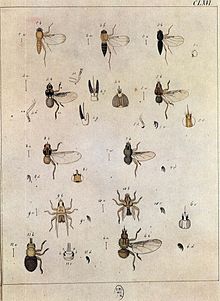Melophagus is a genus of flies in the family Hippoboscidae.[6][7] All are wingless.
| Melophagus | |
|---|---|

| |
| Melophagus ovinus in Europäischen Zweiflügeligen Fig.11 | |
| Scientific classification | |
| Domain: | Eukaryota |
| Kingdom: | Animalia |
| Phylum: | Arthropoda |
| Class: | Insecta |
| Order: | Diptera |
| Family: | Hippoboscidae |
| Subfamily: | Lipopteninae |
| Genus: | Melophagus Latreille, 1802[1] |
| Type species | |
| Hippobosca ovina | |
| Synonyms | |
Species
edit- Melophagus dyspnoetus Maa, 1980
- Melophagus grunini Maa & Doszhanov, 1980
- Melophagus himalayae Maa, 1969[8]
- Melophagus kamtshaticus Doszhanov, 1979
- Melophagus kaukasikus Doszhanov, 2003
- Melophagus ovinus (Linnaeus, 1758)[2]
- Melophagus pantholopsus Sun, 1996
- Melophagus rupicaprinus Rondani, 1879[9]
Distribution
editThey are native to Europe, Asia and North Africa. M. ovinus ovinus has been introduced to most parts of the world where domestic sheep are kept.
Hosts
editAll are parasites of cloven-hoofed mammals - Family Bovidae, including domestic sheep, domestic cattle, the Mongolian gazelle (Procapra gutturosa), the chamois (Rupicapra rupicapra), the alpine ibex (Capra ibex), the yak (Bos grunniens), plus doubtful records on the argali (Ovis ammon), the bighorn sheep (Ovis canadensis) and the Dall sheep (Ovis dalli).[7]
Females could only mate until 24 hours of emergence from the puparium, after which they stored sufficient sperms to fertilize the egg production.
References
edit- ^ Latreille, P.A. (1802). Histoire naturelle, generale et particuliere, des crustaces et des insectes. Tome troisieme. Paris: Dufart. pp. xii + 13-467 + 1 pp.
- ^ a b Linnaeus, C. (1758). Systema naturae... Ed. 10, Vol. 1. Holmiae [= Stockholm]: L. Salvii. pp. 824 pp. Retrieved 14 November 2022.
- ^ Olfers, I.F.M. von (1816). De vegetativis et animatis corporibus in corporibus animatis reperiundis commentarius. Pars I. Berolini [=Berlin]: Maureriana. pp. vi + 112 + [1] pp., 1 pl.
- ^ Wiedemann, Christian Rudolph Wilhelm (1830). Aussereuropäische Zweiflügelige Insekten. Vol. 2. Retrieved 21 April 2020.
- ^ Nitzsch, C.L. (1818). "Die Familien und Gattungen der Thierinsekten (Insecta epizoica) als Prodromus einer Naturgeschichte derselben" (PDF). Mag. Ent. (Germar). 3: 261–316. Retrieved 19 January 2022.
- ^ Maa, T. C (1963). "Genera and species of Hippoboscidae (Diptera) types, synonymy, habitats and natural groupings" (PDF). Pacific Insects Monograph. 6: 1–186. Retrieved 12 April 2024.
- ^ a b Maa, T. C. (1969). "A Revised Checklist and Concise Host Index of Hippoboscidae (Diptera)". Pacific Insects Monograph. 20. Honolulu: Bishop Museum, Honolulu, Hawaii: 261–299pp.
- ^ Maa, T.C. (1969). "Studies in Hippoboscidae (Diptera). Part 2. Further notes on Lipopteninae (Diptera: Hippoboscidae)". Pacific Insects Monographs. 20: 205–236.
- ^ Rondani, C. (1879). "Hippoboscita Italica in familias et genera distributa". Bullettino della Società Entomologica Italiana. 11: 3–28. Retrieved 19 January 2022.